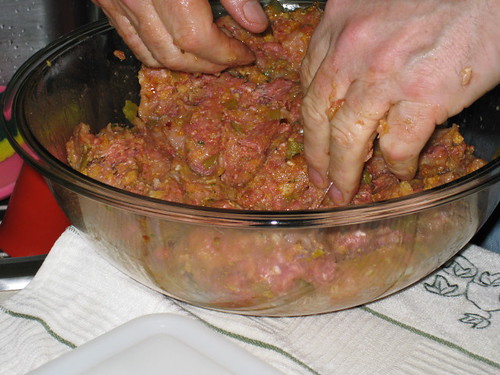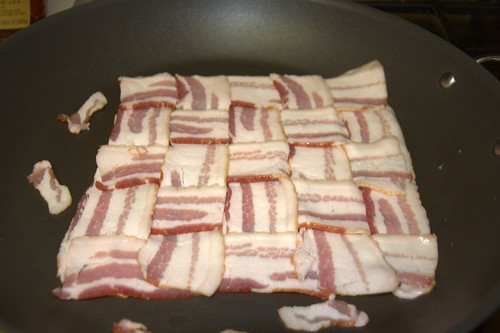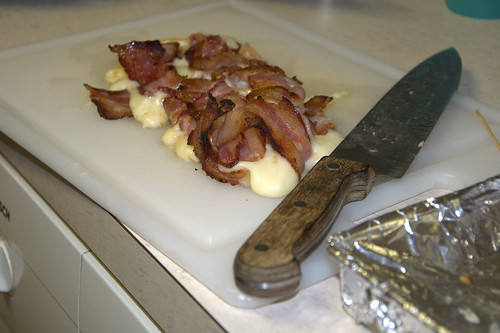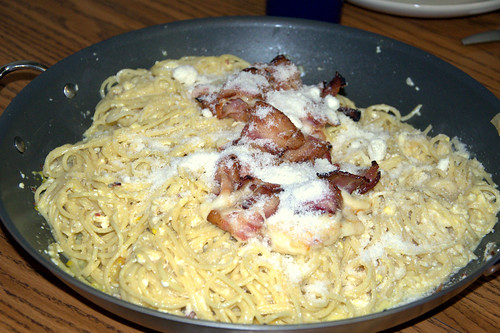I can't resist posting this:
Holy Taco has created a snack food stadium that, upon brief visual inspection, includes guacamole, salsa, queso dip, cheese, sour cream, chex mix, corn chips, cheetos, vienna sausages, bacon and twinkies (for dessert, of course). Did I mention the floating sausage blimp?
Only one more thing to say about this: 24,375 calories.
Photo credits: Holy Taco
Link credits: Serious Eats / Erin Zimmer
Thursday, January 29, 2009
Snack Food Stadium
Posted by
MaryBeth Carroll
at
2:31 PM
0
comments
![]()
![]()
Tags: bacon, fat overload, high cal, link, snacks, superbowl
Friday, January 23, 2009
A Saucy Dilemma
 Although I often try to cook ethnic, traditional, or more gourmet-types of meals, my cooking isn't always all that sophisticated. I like a hot dog every now and again (but don't tell my mother!), and during the week, I eat many simple meals -- perhaps some grilled chicken, brown rice, steamed vegetables. The other day, Dad made a long-simmered tomato sauce (or on Long Island, sawce) and we had it with spaghetti and Italian sausages (sawsages) -- not a terribly complex meal.
Although I often try to cook ethnic, traditional, or more gourmet-types of meals, my cooking isn't always all that sophisticated. I like a hot dog every now and again (but don't tell my mother!), and during the week, I eat many simple meals -- perhaps some grilled chicken, brown rice, steamed vegetables. The other day, Dad made a long-simmered tomato sauce (or on Long Island, sawce) and we had it with spaghetti and Italian sausages (sawsages) -- not a terribly complex meal.
I don't think there is anything traditional OR authentic Italian about Dad's tomato sauce (we're German-Eastern European-Scottish-Irish after all), but it's great and we all love it. He sweats onion, carrot, and later garlic. He adds some tomato paste and browns it to a rusty red (this is a key flavor component, I think). If there's meat involved, that's usually browned before the onions sweat, and is usually removed from the pot, but not always. He usually uses some chopped canned plum tomatoes (bought whole, chopped at home) and perhaps some canned sauce, puree, or some other canned product. [Don't turn your snooty snout up at these ingredients. If you buy good quality canned products, you can do just fine working only from the pantry.] My larger point here is that the end product is not always exactly the same, but it is always good.
I always go back and forth on one issue in particular involving our faux-Italian food, and that is whether I prefer a long-simmered and deeply flavored sauce, or a fresh, bright, tomatoey sauce. It's really difficult to choose, but I suppose it comes down to one ingredient: meat. If there's meat involved, I prefer the long-cooked sauce; no meat, and fresh tomato flavor it is!
Photo credits: FotoRita
Wednesday, January 21, 2009
NYT Dining & Wine 01/21/09
Julia Moskin anoints the cellphone as Top Kitchen Toy. She goes through all the uses you'd think she would including photography, list making, unit conversions, and looking up recipes. I'm still not willing to spend $80 a month on something like an iPhone or Blackberry. It just doesn't add that much value to my life. I'm content using my camera to take pictures, my computer or books to look up recipes, my calculator for unit conversions, and...GASP! pen and paper for lists. I can do all of these tasks BETTER with my current tools.
Eric Asimov dicusses South African wines and proclaims the country "one of the greatest sources for moderately priced cabernet sauvignon on the planet today". Asimov and his panel give a $32 bottle four stars (De Trafford Stellenbosch Cabernet Sauvignon 2004) and has several 'Best Value' recommendations (although $32 really isn't all that bad for a great bottle of wine). Fabricant includes a recipe for Lamb Shanks in Red Wine with Prunes.
Bruni reviews a recently renovated Daniel and says of the many touches: "These flourishes make you feel that you’ve slipped into a monarch’s robes, if only for a night, and turn an evening into an event." He gives Boulud's namesake four stars. No surprise there.
This week's Minimalist column includes a recipe for 15-Minute Fried Herb Chicken, using a paste of onion, herbs, tahini, and olive oil to coat the chicken. Sounds great.
Marian Burros provides insight into the Innaugural Luncheon in the Capitol, although the menu and other details are available at the official Innaugural web site.
Finally, although this isn't in the Dining section, I want to briefly mention something Obama said yesterday in his Innaugural Address: "We will harness the sun and the winds and the soil to fuel our cars and run our factories." I'm all for making the most of the sun and the winds (although I'm a little less pro-wind power as it changes weather patterns), but we just shouldn't be using products from the soil for cars and factories. I won't go in to terrible detail here and now -- perhaps I'll explore this issue in a future post -- but let's use our soil for food -- healthy, nutritous food. We don't need more ethanol and we don't need more corn by-products.
Posted by
MaryBeth Carroll
at
8:23 AM
0
comments
![]()
![]()
Tags: chicken, link, New York Times, Obama, policy, recipe, technology, wine
Tuesday, January 20, 2009
Ewww...Meatloaf
Wednesday, January 14, 2009
NYT Dining & Wine 01/14/09
Today's New York Times Dining & Wine section just didn't interest me all that much. Bit of a disappointment, really.
The one article I truly enjoyed though was Harold McGee's wine science piece. In it, McGee discusses gadgets and techniques for making wine taste better, from frothing to dipping a penny in your glass. I'm no wine snob, but it just seems wrong to mess with wine like that.
I refer you to Serious Eats for a great roundup of today's Dining & Wine section.
Posted by
MaryBeth Carroll
at
3:02 PM
0
comments
![]()
![]()
Tags: New York Times, science, wine
Pierre Herme's Emotion Wasabi et Pamplemousse
Pierre Herme has created a sort of wasabi-grapefruit parfait. Really interesting idea. He begins with a wasabi gelee, followed by some fresh grapefruit and grapefruit confit, then a layer of marscapone and wasabi creme angalaise, topped with pistachios.
The video is entirely in French, but watch it anyway. I understood quite a bit and I haven't spoken French in years.
Thanks to Clotilde for the link
Posted by
MaryBeth Carroll
at
12:11 PM
0
comments
![]()
![]()
Tags: grapefruit, link, video, wasabi
Saturday, January 10, 2009
Congratulations!
I just want to take a minute to congratulate two of my favorite blog authors -- perhaps my two MOST favorite. Yeah, superlatives aren't my strength.
Adam Roberts, the Amateur Gourmet, has been writing his funny, informative blog for five years now. I've been reading for most of that time and his posts really make me happy and want to get in the kitchen or eat something great. That's all I could ever hope for my readers (if I had some), so I hope Adam is happy with that as well. Great job, Adam!
Gina Trapani of Lifehacker is moving on to pursue some other things. She's a really inspiring person for lots of reasons and I wish her well. Not sure what her next project is, but this will be a huge loss for Lifehacker. I read religiously and I'm confident the other editors and contributors can maintain the high standards Gina had in place. Best of luck, Gina!
Posted by
MaryBeth Carroll
at
11:04 AM
0
comments
![]()
![]()
Tags: miscellany, non-food
My French Press Procedure
 For Christmas, I got Tackle a 17 oz Bodum Brazil French Press - the same pot I use on a daily basis in my office. I also gifted him some Biggby coffee, arguably my favorite coffee.
For Christmas, I got Tackle a 17 oz Bodum Brazil French Press - the same pot I use on a daily basis in my office. I also gifted him some Biggby coffee, arguably my favorite coffee.
However, I suppose I left out a few essential items, as well as instructions. Granted, the instructions would produce coffee the way I like it, but having consumed much joe with Tackle, I think I have a good idea of his tastes.
I think the most important aspect of a great cup of coffee is the coffee itself. That means good, fresh beans. In a perfect world, I'd use whole beans, grind them immediately before combining with water, and that would be that. However, since I do most of my brewing at work, grinding daily is out of the question. Also, I don't have a burr grinder, nor the purse to get one, and I really think that's the only way to grind beans for French Press coffee. Therefore, I leave it to the experts and buy coarse-ground coffee from quality suppliers -- Fairway or Biggby. Both roast their own beans and the brews made from them taste great. I make sure to store ground coffee in airtight containers. Opaque is ideal, but I just keep the coffee in the dark under my desk where it's relatively cool. I also buy less more often, rather than more less often. Coffee is one thing that should not be bought in bulk.
When it comes to daily brewing, I have a bit of a ritual. I begin by filling my Brita Pitcher with cool tap water. Good water is key, especially when your only ingredients are coffee and water. I fill my electric kettle with 0.5 liters of filtered water and flip the switch. If I was less lazy and didn't mind making an even bigger production in the office, I'd fill my mug up with hot tap water. However, since I have the somewhat disgusting habit of washing my mug the morning after drinking the coffee, it's already warm from washing.
Anyhow, I wait for my kettle to reach a boil, then click off. I've read many times that the water should be 190-200F, not 212F, so I wait until the kettle clicks off, then add my coffee to the pot. For one mug, I use 2.5 scoops of coarse ground coffee. How big is a scoop? I think about 1 tablespoon. The scoop came with my press. By this time, I think the water should be around 200F. I add all of the water and stir with a chopstick. Then, I let the coffee steep for 2-3 minutes. I press the filter down slowly and decant into my mug immediately. When I use my larger press at home, I make sure not to leave any "extra" coffee in the pot. It will continue to brew and will taste bitter and disgusting. It should be put in a thermos, or never made in the first place.
I always drink my French Press coffee black because I think it has excellent flavor and body without dairy or sugar. However, even if you *need* milk and/or sugar, I strongly urge you to try a French Press. It's not that much more work, effort, or time than any other method and has great results.
One final note: I just want to emphasize the importance of an even, coarse grind on the beans. They must be even in size so extraction is done evenly. It must be coarse so the grinds don't clog or go through the filter.
Photo credits: maggiejumps
Posted by
MaryBeth Carroll
at
9:37 AM
4
comments
![]()
![]()
Wednesday, January 07, 2009
NYT Dining & Wine 01/07/09
There are a couple of interesting articles in today's New York Times Dining & Wine section (published every Wednesday).
Julia Moskin's article "From Asia, Rapture in a Bowl" discusses the enthusiasm people have for various Southeast Asian noodle soups. They all sound tasty, especially as I sit here and sniffle. Unfortunately, there are no recipes included with the article.
Mark Bittman, the Minimalist, gives some pointers for a great pantry, and I don't think I disagree with anything he says (although I'm not throwing out all our spices and bread crumbs). However, a few things really resonated with me:
OUT Canned beans (except in emergencies).
IN Dried beans. More economical, better tasting, space saving and available in far more varieties. Cook a pound once a week and you’ll always have them around (you can freeze small amounts in their cooking liquid, or water, indefinitely). If you’re not sold, try this: soak and cook a pound of white beans. Take some and finish with fresh chopped sage, garlic and good olive oil. Purée another cup or so with a boiled potato and lots of garlic. Mix some with a bit of cooking liquid, and add a can of tomatoes; some chopped celery, carrots and onions; cooked pasta; and cheese and call it pasta fagiole or minestrone. If there are any left, mix them with a can of olive-oil-packed tuna or sardines. And that’s just white beans.
IN Genuine grains. Critical; as many different types as you have space for. Short grain rice — for risotto, paella, just good cooked rice — of course. Barley, pearled or not; a super rice alternative, with any kind of gravy, reduction sauce, pan drippings, what have you. Ground corn for polenta, grits, cornbread or thickener (whisk some — not much — into a soup and see what happens). Quinoa — people can’t believe how flavorful this is until they try it. Bulgur, which is ready in maybe 10 minutes (it requires only steeping), and everyone likes. If you’re in doubt about how to cook any of these, combine them with abundant salted water and cook as you would pasta, then drain when tender; you can’t go far wrong.
Bittman also recommends pureeing some walnuts with garlic, oil, and water as a pasta sauce or condiment for vegetables or grains. That sounds absolutely delicious and slightly healthier than some other pantry-backed dishes like bacon parmigiana.
Florence Fabricant has an excellent looking recipe for duck fried rice. She also has a short write-up about Dousoeur de Paris Patisserie Salon, which sounds about as authentic as any patisserie in the US could hope to be.
Posted by
MaryBeth Carroll
at
9:12 AM
0
comments
![]()
![]()
Tags: beans, grains, New York Times, pantry
Tuesday, January 06, 2009
At the Stove, a Dash of Science, a Pinch of Folklore
Today's New York Times Science section has an article by Kenneth Chang about food science. He made a few dishes and allowed biochemist, cook, and author Shirley Corriher to critique his practices from adding sugar to stir fry to soaking fish in rice wine for a few minutes. Chang also consults food scientist Harold McGee and Sichuan food expert Fuchsia Dunlop.
Posted by
MaryBeth Carroll
at
8:19 AM
0
comments
![]()
![]()
Tags: New York Times, science, technique
Monday, January 05, 2009
French Press: Attempt #2
Tonight, I decided to attempt another french pressed cup o' joe. I took Pepper's suggestions and put them in action. The final product was much stronger, but I put a little too much milk and sugar in (surprise surprise) so I didn't get the full flavor. I also forgot to stir when I added the water, so I'm sure it might have been even better had I remembered to stir.
Posted by
-M. Onufrey
at
11:01 PM
1 comments
![]()
![]()
Tags: coffee
Skinny Chicken Marsala
So today was the first day of dieting in the Onufrey house. Dad is doing a contest similar to the television show, The Biggest Loser, and the rest of us decided it was time to drop a few pounds. Because of this, it is time to start experimenting with some lower calorie recipes.
Posted by
-M. Onufrey
at
8:54 PM
1 comments
![]()
![]()
First Solo French Press Escapade
So I decided to finally use the present my best good friend/cousin Pepper got me for Christmas. Thats right, I finally broke out the french press and coffee. This is my favorite way to make and drink coffee, so needless to say I was excited to use it.
Posted by
-M. Onufrey
at
12:54 AM
1 comments
![]()
![]()
Tags: coffee
Sunday, January 04, 2009
Suggested Improvements to Death in a Pan
As with any good dish, there is always room for improvement. One such improvement would be with the bacon roast. Perhaps it would be a good idea to cook the bacon a little bit first before weaving it together. This might help it stay together a little better.
Posted by
-M. Onufrey
at
2:32 AM
1 comments
![]()
![]()
Saturday, January 03, 2009
Death in a Pan with a Side of Pasta
So there we were, in our usual spots in the living room, faced with the quotidian question of "What's for dinner?" As usual, Cotton suggested Zorn's (yeah, not happening). The usual suspects had already been consumed in the prior days of the week (Mexican, Chinese, you get the point). As a result of this, there was a craving for delicious pasta in the air.
Cotton and I went downstairs, past the Dolorean's bedroom, and into the pantry to investigate possible ingredients. There was an ample supply of pasta and some tomato products, but I really wasn't feeling a dish with tomatoes.
I brought the pasta upstairs and said "Pepper, now what?" She suggested a carbonara, and asked if there was any bacon in the house. In fact, there was some right in the refrigerator. I also encountered some mozzarella cheese right next to the bacon, and suggested that we use that too.
So, cheese, bacon, and a previous viewing of a bacon cheese roll translated into our first annual bacon roast (or bacon parmagiana as I fondly refer to it) as a tribute to the Epiphany. (Everyone does that don't they?)
Our bacon roast started off like a lattice topping for a pie and then lightly fried in a pan.
We removed it and filled it with about half a pound of the cheese (literally.) We then rolled it, toothpicked it shut, and placed it in a small foil lined roasting pan.
Meanwhile, we boiled the pasta and fried up some garlic slices in the bacon grease. After the pasta cooked for about four minutes it was drained and added to the pan with the garlic and drippings. The egg whites and parmasean were then added and tossed with the pasta.
After about two minutes, six egg yolks were added and tossed in (off the heat) until they were cooked and a nice sauce was formed. The bacon roast was carved and served atop the carbonara with, you guessed it, more parmasean.
Needless to say, this was delicious and took about ten years off of our lives. However, it was soooo worth it. I look forward to next year's bacon roast adventure.
Recipe adapted from The Paupered Chef











